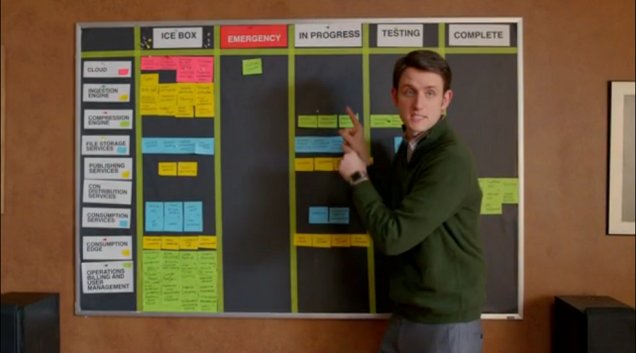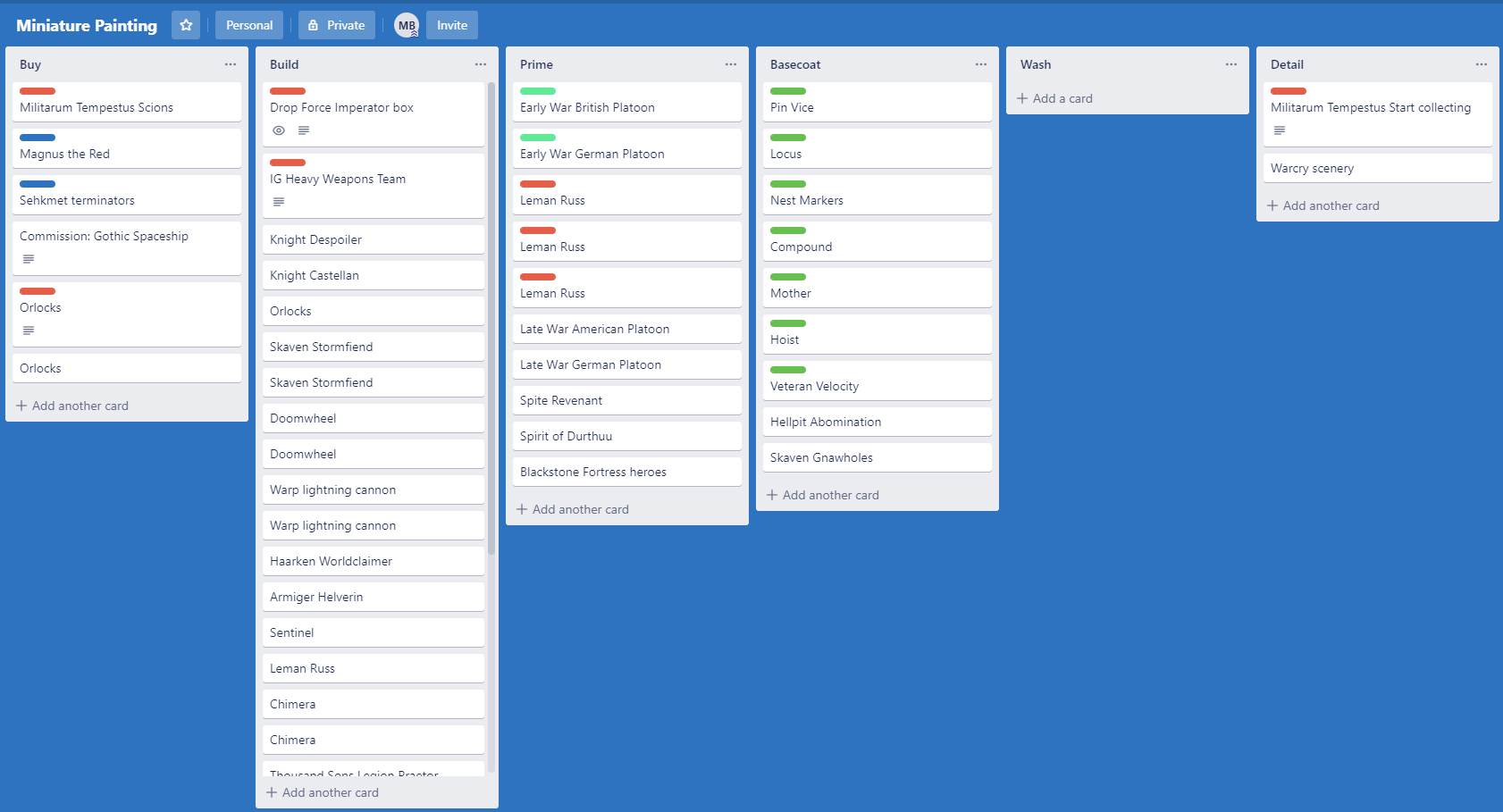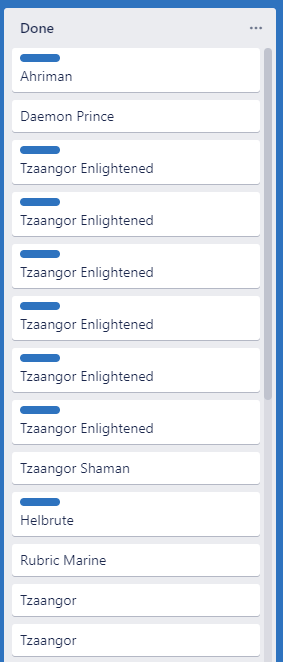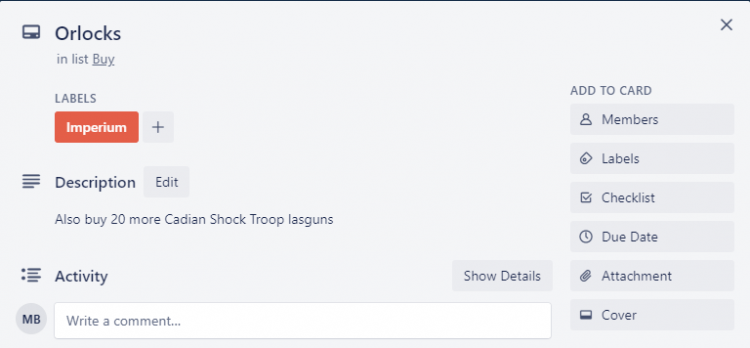One of the most daunting challenges a modeler can face is working through their backlog. While most of our articles talk about how to paint and model, we seldom talk about the process of managing it all. This week, Michael and John are talking about how to manage your backlog and work through that pile of unpainted models.
Project Management: What, Why, and When
Project management is the practice of reducing your to-do list into something achievable by mortal minds and hands. If you’re reading this, then you more than likely have a “backlog”. This backlog, be it models, humble bundle games, unfolded laundry, or unwashed dishes (yes, this article was written specifically for you), is a specific manifestation of anxiety and stress that will come to haunt you. Use the magic of Kanban to fight this daemon, and reduce it to its component parts in order to get your models on the table, and all those other things you’ve been putting off.
Kanban is one of the few useful [fight me, Scrum lords] forms of project management that is most applicable to creative output and managing multi-part, single contributor tasks.
Editor’s Note: There are several methods of project management available, but Kanban is a great way to manage mini backlogs and many popular project management software applications support it

What is Kanban and why should I care?
If you’re like me, somewhere in your home there’s a backlog of unpainted models that grows with all the inevitability of a Necron advance. Coupled with being somewhat of a hobby butterfly, my project area is littered with half painted Scions (Immanentized note: I cannot be allowed to buy more scions) and partially-assembled Sylvaneth. Trying to keep track of all this, both in terms of progress and where I actually left that Skaven Warlock Bombardier, can get overwhelming. When I was keeping on top of my backlog, there was never more than one project being painted and one being built and it takes a certain amount of discipline to stick with this, however it meant my project area was tidy and the backlog shrank at a pretty reasonable pace. I’d like to get back to this, and that means getting back to maintaining my Kanban board.
You may already be familiar with Kanban if you work in software, design or manufacturing, or at least familiar with one of its various incarnation. In its most basic implementation, you get a big pile of sticky notes and a sharpie then write the things you want to get done on them. Once you’ve written them all down, you throw it up on a wall or whiteboard in a column, roughly sorted in priority order. You probably want to break the work flow out a little more than “Buy”, “Paint” and “Done,” though. There are a bunch of great free Kanban tools, the one I use to track my painting progress is Trello.
Kanban operates on the principle of dividing your work up into manageable (and well-labelled) chunks. The idea is to concentrate similar or identical efforts into single elements. You may already be doing this when speed painting, or working on a single color at a time, by consolidating multiple instances of the same task into a single work period, you reduce the time spent setting up, pausing, planning, or otherwise not working. Consolidation of tasks is one of the oldest and most instinctual parts of the project management process, and it takes just a little more effort to turn into proper and formal management
Defining your work flow
These are the steps you take to complete a miniature, broken out into discrete phases. Most of these are probably fairly obvious but you don’t want too many, or too few. I personally use the following:
- Buy
- Build
- Prime
- Basecoat
- Wash
- Detail
- Highlight
- Base
- Varnish
- Photograph
- Done

Sometimes I’ll skip a step or two but as a task is completed I move the sticky note or task card to the next column. So Buy is effectively army planning and a shopping list, once things are purchased they get moved to the Build column, which is the giant pile of boxes on top of my Kallax.
Let’s take the incredibly long list of individual Tzaangors below, which almost drove me insane. Once I had them built, they were moved over to the Prime column, and with the digital move I also took them over to the area where I prime my models. It’s a physical reminder if you’re using a digital board, and it helps keep the workspace well ordered.
With the models primed, I moved on to base coating with the airbrush. This meant I didn’t have a physical move, but I still updated the Trello board. I included painting in the metals as part of basecoat, and this is where I started going a little mad. All those god damn girdles. I got there in the end though, and carried on bumping the models through a section as the steps were completed and finally putting them in the Done column was deeply satisfying.
So what do you do when you want to revisit a piece? I think this is an exercise for the reader, personally I’d move the story back in to the column it’s revisiting. I have a group of Scions from a failed attempt at an army that’ll be paying a hopefully brief visit to the Basecoat column sometime in the future. For now I’m still counting them as done, but I know they’re there.

Classifying your Tasks
When I first started out with Kanban for miniature painting I made the mistake of making my stories far too small. While I was familiar with using them at work, I wasn’t entirely sure how to approach it at home. It turns out tracking every individual Tzaangor when you’re batch painting them 10 at a time is a path to madness, which is exactly what Tzeentch would want (I actually think he’d prefer 9).
Now I typically break down a piece of work in to five models or a single box, whichever is smaller. This gives you a manageable story which you can progress from column to column, feeding a sense of accomplishment.
Using a Kanban tool like Trello gives you other opportunities too. While a project is in progress, you can plan additional purchases or keep notes within the cards. I’m in the process of building out a battalion of Imperial Guard using Orlocks right now, and need to keep a rough track of how just how many more Cadian Shock Troop lasguns I need. You can see in the Orlock card image I’ve also labelled it, so every major force has it’s own colour within the backlog.
Setting goals
In Badcast Episode 59 – Garbage, Air-Dropped from a Butt Dan and SRM spend a little bit of time talking about setting goals when building your army. This might be 500 point chunks, filling out a force organization chart or getting a unit done for a tournament. Having solid goals helps motivate, and if you can time box them and break it down in to chunks even better. You should have an idea of what kind of progress you can make in a week, so pick a day and set a goal for the following week, or two weeks.
Additionally, be extremely honest with your availability, and make space for the times where you just don’t want to work on something. Part of avoiding “hobby burnout” is identifying and cutting out the parts of the hobby that become repetitive or onerous quickly, and substituting something more interesting, dynamic, or different enough to keep up with your progress while not overwhelming yourself. This is super important when working on large single models or vehicles as motivation can quickly blow away when edge highlighting your 35th armor panel on that Baneblade.
Practical – Mise en place
We’re going to get fancy here with some French. While not strictly part of the Kanban process, “Mise En Place”, or, the idea of setting yourself up for success with organized and efficient placement and combinations of different phases of work comes from culinary preparation and placement of items and ingredients for rapid, accurate, and timely implementation into the larger whole
The trick for this, as in most things organization-related is to start small, and start slow. My advice here is to sit down with a notepad while you work on a test miniature, or a test list and record every individual action you take, think to yourself where something can be paused, and repeated at scale. Do it once, then do it twice. Measure each iteration, and compare the time it took you to finish your first with the second. You may already be familiar with some aspects of this from your painting, and this is basically operating off the same concept “sub-assemblies” do.
For example, assembling 67 scions means that you’re assembling 134 identical torso halves, on top of a selection of about 13 different sets of legs (ok, 13.4).
Now, you can either assemble each leg/torso assembly individually, at a time of around 7 minutes per model (glue needs to set and dry to support the whole model, a total investiture of nearly 8 hours), or you can spend about two and a half hours snipping, cutting and arranging your parts with an efficiency that would make Henry Ford blush.
A chunk of this can be “pre-build legs”, or “pre-build torsos”, in between the clipping, filing, and fitting, you will find yourself slipping into a rhythm that makes the work easier, more intuitive and after a period, better. Once you have your piles of legs, and piles of assembled torsos, it’s a simple matter of combining the two with a dab of thick plastic glue.
Editor’s Note: This is incredibly helpful when you have to plan hobby work for a major tournament or event, and need to figure out how much time you’ll have to work on new models.
Ongoing Management
Consistency is key, it’s easy to start slipping or forget to update the board and you’ll quickly end up in a position where you’re not sure what phase each project should be in. Don’t worry if this happens, it’s where I’m at right now. My current plan is just to work through and visually confirm where everything is at, and then up date my board. Once I’ve done this, I’ll pick a project to work through to completion. I think the Badcast recently had a really great discussion on what constitutes a “completed” army, and I think while the macro-focus on a completed army is interesting, it can also be crippling, and an early derailing of your hobby progression. The trick is to develop natural stopping points that get you to where you need to be. I (Immanentized) love the process of thinking up, collecting parts for, building, and then painting individual figures, but I also like the idea of a completed, cohesive squad, which is what I use to organize my efforts and ensure my desk doesn’t get too cluttered.
The hobby part of 40k, (gaming is for nerds.) is a truly accessible and valid form of artistic expression, and like any art form, needs some discipline to reach its full potential and provide the greatest benefits. By implementing some organization to your process, you not only feel better, but work better, and allow your skills to develop to even greater levels.
N.B. The net result of writing this article for me (Pvt_Snafu) was actually committing to finishing my Sylvaneth backlog, which also happens to give me more than 2000 points and some flexibility.
Hopefully we’ve given you a framework for formalizing and improving your process, so you can work through your backlog more efficiently and spend more time painting and less time worrying about how much painting you have to do. As always, if you have any questions, comments, or feedback, feel free to drop a note for us in the comments below, or email us at contact@goonhammer.com. Let us know how you manage your backlog, or any tricks you use.



